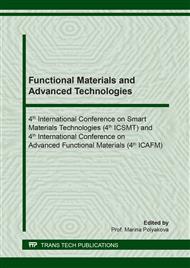p.32
p.37
p.42
p.49
p.57
p.67
p.75
p.82
p.90
Assessment of GFRP Mechanical Properties in Order to Determinate Suitability for UAV Components
Abstract:
Mechanical properties of several composite materials were assessed in order to establish their suitability for unmanned aerial vehicle components manufacturing. The materials under evaluation consisted in E-glass fiber (satin/twill weave) impregnated with polyester, respective epoxy resin. The study was focused on two mechanical tests: low-velocity impact and tensile tests. Based on the results obtained, it was observed that configurations reinforced with twill weave presented higher tensile strength compared with satin reinforced configurations. Moreover, they presented a lower damage degree in case of impact tests. It was concluded that fabric quality has a considerable influence on the impregnation process and on the composite material mechanical properties. In the present case, the twill weave impregnated with epoxy resin can be used to manufacture small range UAV components.
Info:
Periodical:
Pages:
57-66
Citation:
Online since:
March 2020
Keywords:
Price:
Сopyright:
© 2020 Trans Tech Publications Ltd. All Rights Reserved
Share:
Citation:


